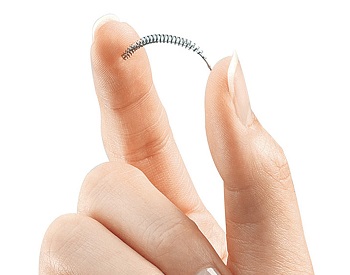Women who opted for a nonsurgical contraceptive implant had a similar risk of unintended pregnancy as women who had tubal ligation, but had more than 10 times the risk of post-procedure reoperation, according to an observational cohort study published online October 13, 2015 in the British Medical Journal.
This is the first population-based study to compare the efficacy of hysteroscopic sterilization using the Essure® contraceptive implant with laparoscopic sterilization.
In this investigation, researchers used a New York State health records database to review outcomes of 8,048 patients undergoing hysteroscopic sterilization and 44,278 undergoing laparoscopic sterilization between 2005 and 2013. They found that hysteroscopic sterilization with the Essure implant increased from 0.6% of all surgeries in 2005 to 25.9% in 2013. Also, hysteroscopic sterilization was performed more often in older patients and those with comorbidity, compared with laparoscopic tubal ligation.
Risk of reoperation
Although the occurrence of unintended pregnancy was about the same in both groups, the researchersfound that patients who had hysteroscopic sterilization with the Essure device had more than 10 times higher risk of reoperation compared with patients who underwent laparoscopic sterilization—which translated into about 21 additional reoperations per 1,000 patients undergoing surgery.
The researchers extrapolated that nearly one-fourth of the estimated 600,000 women per year nationwide who underwent a permanent birth control procedure chose hysteroscopic sterilization. “This means that nationally more than 10,000 women likely underwent additional surgery in the past 5 years,” said lead investigator Art Sedrakyan, PhD, ScD, MD, professor of healthcare policy and research at Weill Medical College of Cornell University, in New York, NY.
The researchers did not enumerate the types of reoperation that patients required, but “most are done to fix the device failures and complications,” Dr. Sedrakyan noted. Postmarketing studies described complications such as perforations, migrations, and expulsions of the contraceptive implant—most of which would require a reoperation, possibly hysterectomy, the researchers wrote.
How it works
The Essure device, which the FDA approved in 2002, is marketed by Bayer HealthCare as “the only permanent birth control with a nonsurgical procedure.” It is a metal spring made from a nickel-titanium alloy that the surgeon inserts into the fallopian tube by hysteroscope. Essure’s website says the procedure takes about 10 minutes and doesn’t require general anesthesia. (The Weill Cornell Medicine researchers found in their study that general anesthesia was still used in half of patients undergoing hysteroscopic sterilization.)
Following insertion, scar tissue grows around the device over time, forming a barrier that prevents fertilization. After about 3 months, an X-ray hysterosalpingography is performed to make sure that the device is in place and to confirm tubal occlusion. Patients are advised to use a backup birth control method until this test confirms that the fallopian tubes are blocked.
Patient complaints
Since Essure’s introduction, the FDA has registered more than 5,000 reports of patient complaints about the device. Most patients reported multiple problems. Their most frequently reported problems were pain, heavier menses/menstrual irregularities, headache, fatigue, and weight fluctuations. The most frequent problems with the device itself were patient-device incompatibility (for example, possible nickel allergy), migration of the device, device operating differently than expected, device breakage, and device malposition.
On September 24, 2015, the FDA convened an open hearing of its Obstetrics and Gynecology Devices Panel to discuss these concerns. Several panelists suggested that a registry be considered to follow implanted patients and gather additional information related to adverse events. More information is needed about metal reactions and sensitivity, they agreed. The panel also suggested that patients with a known hypersensitivity to metal, autoimmune disease, history of pelvic inflammatory disease, and those with a history of abnormal uterine bleeding may be less suitable candidates for the Essure system.
“FDA will continue to monitor the safety of Essure to ensure it does not pose an increased risk to public health and that its benefits continue to outweigh the risks,” the agency stated.
After the hearing, Bayer HealthCare’s Chief Medical Officer Michael Devoy, MB, BS, said in a statement, “We continue to believe that the benefits of Essure continue to outweigh its risks, and we look forward to working closely with the FDA.”
Meanwhile, the Weill Medical College of Cornell University researchers advised physicians and patients to have “deeper communication” about the risks associated with Essure. They also recommend the creation of national and state registries to track specific safety issues related to the device.
“Establishing registries can help us elucidate specific complications that lead to repeat surgeries and better understand if it is possible to overcome technological limitations that cause these device failures,” Dr. Sedrakyan said.
“We hope this publication and dissemination will lead to appropriate action by decision makers,” he added.





